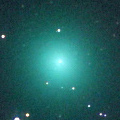
|
It brightened rapidly up to 6.8 mag (Jan. 6, Katsumi Yoshimoto). It will approach to the sun down to 0.3 a.u. on Jan. 14. Now it is not observable. It is not observable after this in the Northern Hemisphere. In the Southern Hemisphere, it will appear in the extremely low sky in the evening in late February.
Date(TT) R.A. (2000) Decl. Delta r Elong. m1 Best Time(A, h)
Jan. 14 18 40.90 -19 39.3 1.154 0.319 14 6.4 5:38 (290, -5)
Jan. 21 19 36.14 -27 54.3 1.292 0.381 11 7.4 5:37 (294,-15)
|
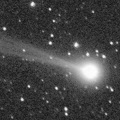
|
It brightened very rapidly as predicted. Now it is very bright as 6.3 mag (Jan. 6, Maik Meyer). It will approach to the earth down to 0.08 a.u. to the earth in mid February, and it is expected to be observable at 6 mag in good condition. It will be unobservable temporarily in January. Then it keeps observable in good condition after mid February.
Date(TT) R.A. (2000) Decl. Delta r Elong. m1 Best Time(A, h)
Jan. 14 21 12.02 -15 9.7 0.431 0.606 22 6.9 18:39 ( 70, 3)
Jan. 21 21 3.39 -12 35.2 0.313 0.685 14 7.0 18:45 ( 78, -4)
|
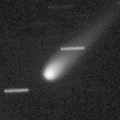
|
Now it is 11.3 mag (Jan. 6, Maik Meyer). It is expected to brighten up to 7 mag in 2017 summer. In the Northern Hemisphere, it keeps observable in good condition until the highlight while the comet will be brightening. In the Southern Hemisphere, it will be observable in spring, but it keeps very low for a while.
Date(TT) R.A. (2000) Decl. Delta r Elong. m1 Best Time(A, h)
Jan. 14 15 0.19 44 7.0 2.293 2.523 91 10.5 5:38 (238, 67)
Jan. 21 15 14.16 44 15.4 2.197 2.460 93 10.3 5:37 (236, 70)
|
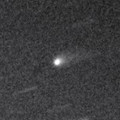
|
Now it is 11.7 mag (Jan. 7, Thomas Lehmann). It is expected to brighten up to 7 mag in 2017 spring. But it locates somewhat low at the high light.
Date(TT) R.A. (2000) Decl. Delta r Elong. m1 Best Time(A, h)
Jan. 14 15 37.57 -21 28.9 2.444 2.072 56 11.6 5:38 (323, 24)
Jan. 21 15 55.71 -22 14.9 2.300 1.989 59 11.3 5:37 (325, 24)
|

|
Already bright as 11.8 mag (Jan. 10, Thomas Lehmann). It will pass the perihelion on Mar. 10. In the Northern Hemisphere, it keeps observable in the evening sky until late February while the comet will be brightening up to 8.5 mag. In the Southern Hemisphere, it will appear in the morning sky in late March at 8 mag, then it keeps observable while the comet will be fading.
Date(TT) R.A. (2000) Decl. Delta r Elong. m1 Best Time(A, h)
Jan. 14 23 13.94 4 47.7 1.389 1.204 57 12.5 18:39 ( 65, 39)
Jan. 21 23 22.10 5 20.9 1.354 1.095 53 11.4 18:45 ( 70, 34)
|

|
Now it is 14.2 mag (Jan. 6, Ken-ichi Kadota). It will brighten up to 12 mag from winter to spring. In the Northern Hemisphere, it keeps observable while the comet is brightening gradually. But it will be unobservable in late February. In the Southern Hemisphere, it keeps observable for a long time after this.
Date(TT) R.A. (2000) Decl. Delta r Elong. m1 Best Time(A, h)
Jan. 14 15 58.51 -13 40.4 1.607 1.296 53 13.0 5:38 (313, 27)
Jan. 21 16 27.99 -15 37.2 1.540 1.237 53 12.7 5:37 (314, 25)
|

|
Now it is not observable. It will appear in the morning sky in March.
Date(TT) R.A. (2000) Decl. Delta r Elong. m1 Best Time(A, h)
Jan. 14 20 20.80 -20 42.6 6.843 5.873 8 13.9 18:39 ( 72,-10)
Jan. 21 20 26.68 -20 18.5 6.853 5.871 3 13.9 18:45 ( 76,-16)
|
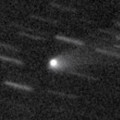
|
Now it is 14.9 mag (Jan. 6, Hiroshi Abe). It will brighten up to 14 mag from winter to spring, and it will be observable in excellent condition in the Northern Hemisphere. It keeps low in the Southern Hemisphere.
Date(TT) R.A. (2000) Decl. Delta r Elong. m1 Best Time(A, h)
Jan. 14 12 0.47 26 51.3 1.777 2.439 121 14.1 4:27 ( 0, 82)
Jan. 21 12 4.05 27 37.1 1.726 2.447 126 14.1 4:03 ( 0, 82)
|

|
Now it is 14.3 mag (Dec. 31, Jakub Cerny). Distant object, but it keeps observable at 13-14 mag for a long time from 2015 to 2016.
Date(TT) R.A. (2000) Decl. Delta r Elong. m1 Best Time(A, h)
Jan. 14 0 49.76 -4 6.3 5.309 5.164 76 14.8 18:39 ( 31, 46)
Jan. 21 0 53.92 -3 42.9 5.429 5.180 70 14.8 18:45 ( 41, 43)
|

|
Now it is bright as 14.4 mag (Dec. 25, Thomas Lehmann). It will be observable at 11 mag for a long time from 2017 to 2018. Now it is observable in excellent condition in the Southern Hemisphere. But it keeps low for a while in the Northern Hemisphere.
Date(TT) R.A. (2000) Decl. Delta r Elong. m1 Best Time(A, h)
Jan. 14 2 47.37 -34 29.7 5.252 5.351 90 14.9 19:11 ( 0, 21)
Jan. 21 2 46.62 -33 11.0 5.276 5.299 85 14.9 18:45 ( 0, 22)
|
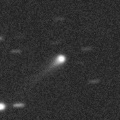
|
It brightened very rapidly up to 12 mag in autumn, brighter than originally expected. It will not be observable after this.
Date(TT) R.A. (2000) Decl. Delta r Elong. m1 Best Time(A, h)
Jan. 14 20 14.36 -11 3.0 3.069 2.121 12 14.9 18:39 ( 81, -6)
Jan. 21 20 30.11 -9 55.8 3.099 2.141 10 15.3 18:45 ( 84, -9)
|
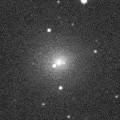
|
It brightened up to 11-12 mag in autumn. Now it is fading. But it is bright as 12.5 mag still now (Jan. 7, Thomas Lehmann). It is getting higher gradually after this also in the Southern Hemisphere.
Date(TT) R.A. (2000) Decl. Delta r Elong. m1 Best Time(A, h)
Jan. 14 13 35.99 -14 28.1 1.856 2.044 86 15.1 5:38 (352, 40)
Jan. 21 13 42.80 -15 13.0 1.819 2.092 91 15.3 5:37 (359, 40)
|
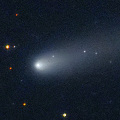
|
It brightened up to 11-12 mag from summer to autumn. Now it is fading. But it is bright as 12.4 mag still now (Dec. 29, Jakub Cerny).
Date(TT) R.A. (2000) Decl. Delta r Elong. m1 Best Time(A, h)
Jan. 14 12 27.60 -24 12.1 1.692 2.060 97 15.1 4:54 ( 0, 31)
Jan. 21 12 30.25 -25 19.0 1.660 2.108 102 15.3 4:29 ( 0, 30)
|

|
Now it is 14.8 mag (Dec. 31, Yuji Ohshima). It keeps 15 mag until spring. But it will be getting lower gradually after this.
Date(TT) R.A. (2000) Decl. Delta r Elong. m1 Best Time(A, h)
Jan. 14 23 38.70 6 46.9 1.953 1.766 64 15.2 18:39 ( 61, 45)
Jan. 21 23 53.72 8 37.9 1.989 1.748 61 15.2 18:45 ( 67, 43)
|

|
It brightened up to 11 mag from spring to summer in 2016. Now it is not observable. It will be observable at 16 mag again in 2017 spring.
Date(TT) R.A. (2000) Decl. Delta r Elong. m1 Best Time(A, h)
Jan. 14 18 1.62 -21 30.0 3.161 2.292 23 15.2 5:38 (298, 1)
Jan. 21 18 15.90 -21 28.0 3.164 2.334 27 15.3 5:37 (299, 3)
|

|
Now it is 15.4 mag (Jan. 9, Thomas Lehmann). It will approach to the earth down to 0.14 a.u. from March to April. It is expected to brighten up to 5-6 mag. It may brighten furthermore in outburst. In the Northern Hemisphere, it keeps observable in excellent condition. In the Southern Hemisphere, it will not be observable for about one month around the highlight. But it keeps observable in good condition except for that period.
Date(TT) R.A. (2000) Decl. Delta r Elong. m1 Best Time(A, h)
Jan. 14 9 25.96 7 51.7 0.607 1.545 151 15.8 1:53 ( 0, 63)
Jan. 21 9 28.70 8 40.4 0.527 1.486 158 15.2 1:28 ( 0, 64)
|

|
Now it is 15.8 mag (Jan. 1, Ken-ichi Kadota). It will brighten up to 12-13 mag and will be observable in good condition in 2017 summer. In this winter, it is observable until mid January in the Southern Hemisphere, or until the end of February in the Northern Hemisphere.
Date(TT) R.A. (2000) Decl. Delta r Elong. m1 Best Time(A, h)
Jan. 14 0 12.13 15 36.1 3.678 3.565 75 15.5 18:39 ( 63, 56)
Jan. 21 0 9.90 14 56.5 3.770 3.522 67 15.4 18:45 ( 71, 49)
|

|
Now it is 15.7 mag (Jan. 4, T. Ikemura, H. Sato). It will brighten up to 14 mag from spring to summer in 2017. It locates somewhat low in the Northern Hemisphere. The perihelion distance increased from 2.4 a.u. to 2.9 a.u. in this apparition. So it will not be bright as before.
Date(TT) R.A. (2000) Decl. Delta r Elong. m1 Best Time(A, h)
Jan. 14 15 29.81 -15 34.4 3.583 3.204 59 15.6 5:38 (321, 30)
Jan. 21 15 38.18 -16 9.5 3.482 3.191 64 15.6 5:37 (326, 31)
|

|
Now it is 15.8 mag (Dec. 3, Kunihiro Shima). It will brighten up to 14 mag from summer to winter in 2017. Then it will be observable in excellent condition in the Northern Hemisphere. In the Southern Hemisphere, it is hardly observable around the highlight.
Date(TT) R.A. (2000) Decl. Delta r Elong. m1 Best Time(A, h)
Jan. 14 22 56.33 -2 54.3 4.500 3.949 50 15.7 18:39 ( 62, 30)
Jan. 21 22 59.56 -1 38.6 4.549 3.912 44 15.7 18:45 ( 68, 25)
|

|
Now it is 15.6 mag (Jan. 9, J. L. Martin). It will be observable at 16-17 mag in good condition from autumn to winter. It locates low in the Southern Hemisphere.
Date(TT) R.A. (2000) Decl. Delta r Elong. m1 Best Time(A, h)
Jan. 14 7 2.80 27 6.6 2.791 3.762 169 15.7 23:26 ( 0, 82)
Jan. 21 6 57.79 27 19.4 2.809 3.755 161 15.7 22:53 ( 0, 82)
|
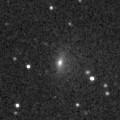
|
Now it is 15.7 mag (Dec. 30, Sandor Szabo). It keeps 16-17 mag for a long time from 2016 to 2019. It keeps locating near by the equator.
Date(TT) R.A. (2000) Decl. Delta r Elong. m1 Best Time(A, h)
Jan. 14 9 18.99 2 3.9 8.788 9.649 149 15.9 1:46 ( 0, 57)
Jan. 21 9 17.55 2 16.4 8.735 9.644 156 15.9 1:17 ( 0, 57)
|

|
It brightened up to 6 mag from last autumn to last winter. Now it is fading. It has already faded down to 16.0 mag (Jan. 1, Yuji Ohshima). It is observable in good condition in the Northern Hemisphere. It is not observable after this in the Southern Hemisphere.
Date(TT) R.A. (2000) Decl. Delta r Elong. m1 Best Time(A, h)
Jan. 14 3 1.71 49 56.1 4.977 5.518 118 15.9 19:26 (180, 75)
Jan. 21 2 58.10 48 56.1 5.136 5.585 112 16.0 18:55 (180, 76)
|

|
It kept bright 12 mag for a long time from autum in 2015 to summer in 2016. Now it is fading. It has already faded dwon to 15.6 mag (Jan. 6, Hiroshi Abe). It is appearing in the morning sky in the Northern Hemispehre. It will be observable in late January also in the Southern Hemisphere.
Date(TT) R.A. (2000) Decl. Delta r Elong. m1 Best Time(A, h)
Jan. 14 17 6.36 -3 44.9 4.779 4.099 41 16.0 5:38 (292, 23)
Jan. 21 17 10.54 -4 18.6 4.758 4.149 46 16.0 5:37 (297, 27)
|

|
Now it is 17.2 mag (Jan. 6, Hiroshi Abe). It will brighten up to 10 mag in summer, and it will be observable in excellent condition in the Southern Hemisphere. It locates low in the Northern Hemisphere.
Date(TT) R.A. (2000) Decl. Delta r Elong. m1 Best Time(A, h)
Jan. 14 14 21.87 -6 15.7 2.152 2.182 78 16.3 5:38 (335, 46)
Jan. 21 14 33.73 -7 13.5 2.036 2.144 82 16.0 5:37 (340, 46)
|

|
Appearing in the morning sky. Now it is fading. But it must be bright as 16 mag still now.
Date(TT) R.A. (2000) Decl. Delta r Elong. m1 Best Time(A, h)
Jan. 14 16 4.78 -20 43.6 2.870 2.370 50 16.0 5:38 (317, 21)
Jan. 21 16 15.92 -20 52.0 2.866 2.441 55 16.2 5:37 (320, 23)
|

|
It was observed at 16 mag from spring to summer in 2016. It will be observable at 16 mag also in 2017 from winter to spring.
Date(TT) R.A. (2000) Decl. Delta r Elong. m1 Best Time(A, h)
Jan. 14 17 0.57 -11 10.9 3.919 3.229 40 16.1 5:38 (299, 19)
Jan. 21 17 10.32 -10 9.0 3.859 3.238 44 16.1 5:37 (302, 23)
|

|
Now it is 16.5 mag (Dec. 29, Sandor Szabo). It will brighten up to 15 mag and will be observable in good condition from autum to winter in 2017. In the Northern Hemisphere, it keeps observable in good condition for a long time while the comet will be brightening. It is not observable until 2017 summer in the Southern Hemisphere.
Date(TT) R.A. (2000) Decl. Delta r Elong. m1 Best Time(A, h)
Jan. 14 1 59.45 46 3.1 4.695 5.087 108 16.4 18:39 (166, 79)
Jan. 21 1 56.14 44 28.0 4.775 5.056 101 16.4 18:45 (137, 76)
|
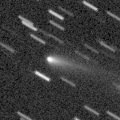
|
It brightened up to 14.6 mag from autum to winter (Dec. 2, Kunihiro Shima). Now it is fading. It has already faded down to 16.3 mag (Jan. 5, E. Bryssinck). It will be fainter than 18 mag in March.
Date(TT) R.A. (2000) Decl. Delta r Elong. m1 Best Time(A, h)
Jan. 14 4 3.53 31 57.2 2.114 2.852 130 16.6 20:28 ( 0, 87)
Jan. 21 4 5.10 31 35.6 2.210 2.876 123 16.8 20:02 ( 0, 87)
|
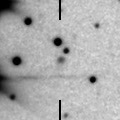
|
Now it is 16.4 mag (Jan. 3, T. Ikemura, H. Sato). It keeps 16 mag for a long time from 2017 to 2018.
Date(TT) R.A. (2000) Decl. Delta r Elong. m1 Best Time(A, h)
Jan. 14 9 23.02 -8 53.4 5.014 5.811 140 16.6 1:50 ( 0, 46)
Jan. 21 9 17.14 -7 59.6 4.934 5.791 147 16.6 1:17 ( 0, 47)
|

|
Now it is 16.5 mag (Dec. 26, A. Diepvens). It keeps 16.5 mag from 2016 to 2017. In the Northern Hemisphere, it keeps observable in good condition for a long time, although it becomes low temporarily in December. In the Southern Hemisphere, it will never be observable again.
Date(TT) R.A. (2000) Decl. Delta r Elong. m1 Best Time(A, h)
Jan. 14 18 1.82 36 45.8 6.637 6.249 62 16.6 5:38 (245, 33)
Jan. 21 18 8.13 37 40.5 6.609 6.251 64 16.6 5:37 (246, 37)
|

|
It brightened up to 15 mag in early 2016. Now it is fading. It has already faded down to 16.3 mag (Dec. 30, Sandor Szabo). In the Northern Hemisphere, it keeps observable in good condition for a long time until 2017 autumn when the comet will be fainter than 18 mag. It will never be observable after this in the Southern Hemisphere.
Date(TT) R.A. (2000) Decl. Delta r Elong. m1 Best Time(A, h)
Jan. 14 15 23.61 67 7.7 5.976 6.230 100 16.8 5:38 (200, 53)
Jan. 21 15 28.72 67 35.3 5.988 6.258 101 16.9 5:37 (197, 54)
|

|
Now it is 16.8 mag (Jan. 6, D. Buczynski). It is expected to brighten up to 9 mag in summer in 2018. In the Northern Hemisphere, it keeps observable until 2018 summer while the comet will be brightening. In the Southern Hemisphere, it is hardly observable in 2017, but it will be observable in good condition in 2018.
Date(TT) R.A. (2000) Decl. Delta r Elong. m1 Best Time(A, h)
Jan. 14 18 28.05 44 57.3 6.426 6.133 68 16.9 5:38 (234, 31)
Jan. 21 18 33.85 44 53.2 6.367 6.078 68 16.9 5:37 (236, 35)
|
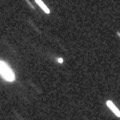
|
Now it is 17.1 mag (Jan. 9, ATLAS-HKO, Haleakala). It brightened rapidly, and became brighter than originally expected. It keeps 17 mag until 2017. In the Northern Hemisphere, it keeps observable in excellent condition for a long time. It is not observable in the Southern Hemisphere.
Date(TT) R.A. (2000) Decl. Delta r Elong. m1 Best Time(A, h)
Jan. 14 13 42.57 57 20.8 6.984 7.346 107 16.9 5:38 (191, 67)
Jan. 21 13 39.38 57 59.6 6.939 7.352 111 16.9 5:37 (180, 67)
|
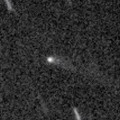
|
Now it is 17.2 mag (Jan. 8, D. Buczynski). It was observed at 17 mag last winter. It will be observable at 17 mag again next winter. It is observable in good condition in the Northern Hemisphere. But it locates low in the Southern Hemisphere.
Date(TT) R.A. (2000) Decl. Delta r Elong. m1 Best Time(A, h)
Jan. 14 11 27.30 25 44.8 3.287 3.976 128 17.1 3:54 ( 0, 81)
Jan. 21 11 27.40 27 33.4 3.243 4.000 135 17.1 3:27 ( 0, 82)
|

|
Now it is 18.2 mag (Dec. 6, T. Ikemura, H. Sato). It was expected to be observable at 17 mag in good condition in winter. But actually, it is fainter than this ephemeris.
Date(TT) R.A. (2000) Decl. Delta r Elong. m1 Best Time(A, h)
Jan. 14 12 43.86 -1 30.6 2.129 2.539 103 17.1 5:10 ( 0, 53)
Jan. 21 12 47.40 -1 24.8 2.068 2.569 109 17.2 4:46 ( 0, 53)
|

|
Now it is 16.1 mag (Dec. 30, Yuji Ohshima). In the Northern Hemisphere, it will be observable at 17 mag in excellent condition in winter. It locates low in the Southern Hemisphere.
Date(TT) R.A. (2000) Decl. Delta r Elong. m1 Best Time(A, h)
Jan. 14 6 54.36 34 58.8 2.475 3.427 162 17.2 23:18 ( 0, 90)
Jan. 21 6 50.14 34 52.5 2.509 3.434 156 17.2 22:46 ( 0, 90)
|

|
It brightened up to 8-9 mag from winter to spring in 2016. Now it is fading. It has already faded down to 17.1 mag (Dec. 6, T. Ikemura, H. Sato).
Date(TT) R.A. (2000) Decl. Delta r Elong. m1 Best Time(A, h)
Jan. 14 13 15.21 -12 42.5 4.610 4.740 91 17.2 5:38 (359, 42)
Jan. 21 13 14.12 -13 21.6 4.550 4.798 98 17.2 5:13 ( 0, 42)
|

|
It will pass the perihelion in 2019. However, it has not been brightening since the discovery in 2010. Now it is 17.1 mag (Jan. 4, T. Ikemura, H. Sato). It keeps observable in excellent condition in the Northern Hemisphere. It is not observable in the Southern Hemisphere.
Date(TT) R.A. (2000) Decl. Delta r Elong. m1 Best Time(A, h)
Jan. 14 3 46.46 61 37.2 9.008 9.583 123 17.2 20:11 (180, 63)
Jan. 21 3 44.24 61 24.8 9.057 9.564 118 17.2 19:41 (180, 64)
|
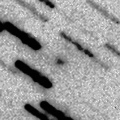
|
Now it is 17.2 mag (Dec. 30, A. Diepvens). In the Northern Hemisphere, it is observable at 17-18 mag until March. It is not observable in the Southern Hemisphere.
Date(TT) R.A. (2000) Decl. Delta r Elong. m1 Best Time(A, h)
Jan. 14 18 31.68 51 2.7 1.938 1.917 74 17.3 5:38 (227, 32)
Jan. 21 18 33.29 53 43.5 1.899 1.928 76 17.2 5:37 (225, 37)
|
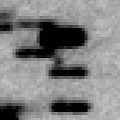
|
Now it is 17.7 mag (Jan. 7, Mt. Lemmon Survey). It will be observable at 17.5 mag in good condition from winter to spring.
Date(TT) R.A. (2000) Decl. Delta r Elong. m1 Best Time(A, h)
Jan. 14 14 19.38 -8 10.1 2.278 2.295 78 17.4 5:38 (337, 44)
Jan. 21 14 29.03 -8 54.2 2.207 2.306 83 17.4 5:37 (342, 44)
|

|
It brightened up to 6.2 mag in June in 2016 (June 24, Marco Goiato). Now it is fading. It has already faded down to 17.1 mag (Jan. 6, B. Lutkenhoner, W. F. Cashwell). In the Southern Hemisphee, it keeps observable in excellent condition after this. It keeps low in the Northern Hemisphere.
Date(TT) R.A. (2000) Decl. Delta r Elong. m1 Best Time(A, h)
Jan. 14 15 6.50 -33 19.0 4.074 3.706 61 17.4 5:38 (335, 17)
Jan. 21 15 4.98 -33 43.7 4.025 3.777 68 17.6 5:37 (341, 18)
|

|
It has been lost since its discovery in 1978. In 2016, it is expected to return in excellent condition from autumn to winter.
Date(TT) R.A. (2000) Decl. Delta r Elong. m1 Best Time(A, h)
Jan. 14 1 22.35 8 17.6 1.148 1.490 88 17.6 18:39 ( 27, 61)
Jan. 21 1 43.24 10 50.1 1.227 1.531 86 18.1 18:45 ( 35, 62)
|

|
Now it is 17.3 mag (Jan. 8, CAO, San Pedro de Atacama). It is observable at 17.5 mag in good condition in this winter in the Southern Hemisphere.
Date(TT) R.A. (2000) Decl. Delta r Elong. m1 Best Time(A, h)
Jan. 14 6 36.96 -49 3.4 3.493 3.911 108 17.6 22:59 ( 0, 6)
Jan. 21 6 25.16 -46 59.8 3.481 3.911 108 17.6 22:20 ( 0, 8)
|
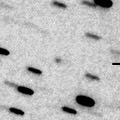
|
Now it is 18.9 mag (Dec. 27, K. Hills). It is observable at 18 mag in good condition from January to March.
Date(TT) R.A. (2000) Decl. Delta r Elong. m1 Best Time(A, h)
Jan. 14 10 53.04 -6 20.2 2.442 3.121 125 17.9 3:20 ( 0, 49)
Jan. 21 10 51.47 -7 1.1 2.388 3.137 132 17.9 2:51 ( 0, 48)
|
|
![]()
 C/2015 TQ209 ( LINEAR )
C/2015 TQ209 ( LINEAR ) C/2016 B1 ( NEOWISE )
C/2016 B1 ( NEOWISE ) C/2015 V1 ( PanSTARRS )
C/2015 V1 ( PanSTARRS ) 56P/Slaughter-Burnham
56P/Slaughter-Burnham C/2016 A1 ( PanSTARRS )
C/2016 A1 ( PanSTARRS ) C/2014 OE4 ( PanSTARRS )
C/2014 OE4 ( PanSTARRS ) C/2013 V4 ( Catalina )
C/2013 V4 ( Catalina ) C/2016 M1 ( PanSTARRS )
C/2016 M1 ( PanSTARRS ) C/2014 R3 ( PanSTARRS )
C/2014 R3 ( PanSTARRS ) C/2015 X7 ( ATLAS )
C/2015 X7 ( ATLAS ) 118P/Shoemaker-Levy 4
118P/Shoemaker-Levy 4 P/2015 TP200 ( LINEAR )
P/2015 TP200 ( LINEAR ) C/2014 S2 ( PanSTARRS )
C/2014 S2 ( PanSTARRS ) C/2010 U3 ( Boattini )
C/2010 U3 ( Boattini ) C/2016 T2 ( Matheny )
C/2016 T2 ( Matheny ) 94P/Russell 4
94P/Russell 4 C/2013 X1 ( PanSTARRS )
C/2013 X1 ( PanSTARRS ) D/1978 R1 ( Haneda-Campos )
D/1978 R1 ( Haneda-Campos ) C/2017 A3 ( Elenin )
C/2017 A3 ( Elenin ) 330P/2015 U1 ( Catalina )
330P/2015 U1 ( Catalina )![]()








































